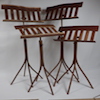Hey guys, so I'm coming here for some advice or tips/tricks things I should know. I'm a pretty experienced wood worker, however I have never done anything live edge. I got some really nice pieces of spalted white oak and I want to make a dining table and coffee table from them. They're 10''; long and roughly 15-16''; wide, and they've been drying for a few years I believe, so the moisture content is around 11-12%. I'm going to cut clean edges on both sides of one board to use as the middle and just one side on each of the others and leave the live edge in tact on both sides. There's not really any splitting or anything but if I do come across any, I'll put a butterfly key in. I really just want to know if there's any tips from people who have done these before. Especially with the finishing. I plan on leaving it as is and just sealing it with some clear Rubio monocoat. Also still undecided on what I'm going to do about the base. Thoughts on everything? I've attached a picture.




 Reply With Quote
Reply With Quote





